
Form Approved
REPORT DOCUMENTATION PAGE
OMB No. 0704-0188
Public reporting burden for this collection of information is estimated to average 1 hour per response, including the time for reviewing instructions, searching existing data sources, gathering and maintaining the
data needed, and completing and reviewing this collection of information. Send comments regarding this burden estimate or any other aspect of this collection of information, including suggestions for reducing
this burden to Department of Defense, Washington Headquarters Services, Directorate for Information Operations and Reports (0704-0188), 1215 Jefferson Davis Highway, Suite 1204, Arlington, VA 22202-4302.
Respondents should be aware that notwithstanding any other provision of law, no person shall be subject to any penalty for failing to comply with a collection of information if it does not display a currently valid
OMB control number. PLEASE DO NOT RETURN YOUR FORM TO THE ABOVE ADDRESS.
1. REPORT DATE (DD-MM-YY)
2. REPORT TYPE
3. DATES COVERED (From - To)
September 2002
Technical Report
4. TITLE AND SUBTITLE
5a. CONTRACT NUMBER
5b. GRANT NUMBER
Army Aircraft Icing
5c. PROGRAM ELEMENT NUMBER
6. AUTHOR(S)
5d. PROJECT NUMBER
5e. TASK NUMBER
Lindamae Peck, Charles C. Ryerson, and C. James Martel
5f. WORK UNIT NUMBER
7. PERFORMING ORGANIZATION NAME(S) AND ADDRESS(ES)
8. PERFORMING ORGANIZATION REPORT
NUMBER
U.S. Army Engineer Research and Development Center
Cold Regions Research and Engineering Laboratory
72 Lyme Road
ERDC/CRREL TR-02-13
Hanover, NH 03755-1290
9. SPONSORING/MONITORING AGENCY NAME(S) AND ADDRESS(ES)
10. SPONSOR / MONITOR'S ACRONYM(S)
Office of the Chief of Engineers
11. SPONSOR / MONITOR'S REPORT
Washington, DC
NUMBER(S)
12. DISTRIBUTION / AVAILABILITY STATEMENT
Approved for public release; distribution is unlimited.
Available from NTIS, Springfield, Virginia 22161.
13. SUPPLEMENTARY NOTES
14. ABSTRACT
Icing is among aviation's most serious weather hazards because it renders aircraft unflyable before flight and severely reduces aircraft
performance within flight. Army aviation is vulnerable to icing, which occurs most frequently at lower altitudes, and which generally has the
greatest impact upon small fixed-wing aircraft and helicopters that fly slowly and low. Icing causes mission delays during ground deicing of
aircraft and mission cancellations and abortions because of forecast or actual in-flight icing. The common notion, however, is that icing is
"not a problem" for Army aviators because they generally "do not fly in icing." This report assesses the effects of icing, both before and
during flight, on the ability of Army aviators to accomplish their mission. Interviews with aviation commands, surveys to aviation com-
mands worldwide, and assessment of Army aviation safety records demonstrate the affect of icing and snow on Army aviation.
15. SUBJECT TERMS
Aviation
Forecast
Icing
Preflight
Safety
Deicing
Helicopters
Inflight
Mission
Snow
16. SECURITY CLASSIFICATION OF:
17. LIMITATION OF
18. NUMBER
19a. NAME OF RESPONSIBLE PERSON
OF ABSTRACT
OF PAGES
a. REPORT
b. ABSTRACT
c. THIS PAGE
19b. TELEPHONE NUMBER (include area code)
U
U
U
U
128
Standard Form 298 (Rev. 8-98)
Prescribed by ANSI Std. 239.18



 Previous Page
Previous Page
